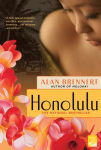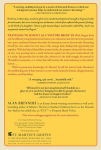A sweeping, meticulously researched saga that sees it plucky heroine, a mistreated but independent-minded Korean mail-order bride, through the highs and lows of life in twentieth-century Hawai'i, this book extends our readers' tradition of favoring lush, flavorful historical novels.” —Elle
“A well-researched and deftly written tale….For sheer readability, it's a hit…. Brennert has a good eye for places we can't see anymore: plantation life before the unions gained power; Chinatown when it was all tenements; Waikiki before the high-rises started going up. And it's clear he has real affection for the little people and places he so vividly brings to life. He's not just using historic Honolulu as a place to set a novel; he's bringing it to life for people who haven't had the chance to imagine it before.” —Honolulu Star-Bulletin
“To its core, Honolulu is meticulously researched….Brennert portrays the Aloha State's history as complicated and dynamic—not simply a melting pot, but a Hawaiian-style ‘mixed plate’ in which, as Jin sagely notes, ‘many different tastes share the plate, but none of them loses its individual flavor, and together they make up a uniquely “local” cuisine.” —The Washington Post
“Successful historical fiction doesn't just take a story and doll it up with period detail. It plunges readers into a different world and defines the historical and cultural pressures the characters face in that particular time and place. That's what Los Angeles writer Alan Brennert did in his previous novel, Moloka'i, the story of diseased Hawaiians exiled in their own land. He has done it again in "Honolulu," which focuses on the Asian immigrant experience in Hawaii, specifically that of Korean picture brides….This is a moving, multilayered epic by a master of historical fiction, in which one immigrant's journey helps us understand our nation's "becoming.” —San Francisco Chronicle
“[A] sweeping, epic novel….Brennert weaves the true stories of early Hawaii into his fictional tale, and many of the captivating people Jin encounters are real. His depiction of the effects of the Depression is startling. Let's hope Brennert follows up this second novel with a third and continues to capture this intriguing and little-explored segment of American history in beautifully told stories.” —Library Journal (starred review)
“[A] poignant, colorful story.” —Kirkus Reviews
“Brennert's lush tale of ambition, sacrifice, and survival is immense in its dramatic scope yet intimate in its emotive detail.” —Booklist
“Intriguing….Honolulu offers endless insights into a culture many readers may never have encountered, and Brennert further enlivens his tale by dropping in historical figures, some fictional, such as Charlie Chan, and some real, such as Clarence Darrow. But it is Korea that's the real focus of this story, and readers get a sympathetic feel for the daily humiliations the native population suffered from the Japanese who conquered the country….[Brennert's] smooth narrative style makes the book a pleasure to read.” —Roanoke Times
“With skill, historic accuracy and sensitivity and a clear passion for the people and places in Hawaii, Brennert weaves a story that will move and inspire readers.” —The Oklahoman
“In this dazzling rich, historical story, a young ‘picture bride' travels to Hawaii in 1914 in search of a better life….This intriguing novel is a fascinating literary snapshot of Hawaii during the early years of the last century. The story is compelling, poignant and powerful.” —Tucson Citizen
As a young Korean woman at the onset of 20th century, Regret knows that there is only one possible avenue to the education she seeks. She must become a mail-order bride. She travels to Hawaii to meet the man she has agreed to marry, but it becomes apparent all too quickly that he is not the genteel, prosperous young man she imagined he would be. Instead, she finds herself yoked to an impoverished plantation worker addicted to alcohol and gambling. Her painful situation forces her to fend for herself and form beneficial alliances with other "picture brides." This powerful historical novel draws you into the plight of a woman swimming in the uncertainty of a new culture.
Honolulu is meticulously researched…[Brennert] intersperses cultural details—song lyrics, movies, popular books from the era—that add textured authenticity, and he incorporates major historic events…In many respects, Jin's story is prototypical, the bildungsroman of an aspiring woman, yearning for a life beyond the one society has prescribed. (Jin Eyre, anyone?) But in mooring this familiar character to the unique history of early-20th-century Hawaii, Brennert portrays the Aloha State's history as complicated and dynamic—not simply a melting pot, but a Hawaiian-style "mixed plate" in which, as Jin sagely notes, "many different tastes share the plate, but none of them loses its individual flavor, and together they make up a uniquely 'local' cuisine."
—The Washington Post
Brennert's mostly successful follow-up to his book club phenomenon, Moloka'i, chronicles the lives of Asian immigrants in and around Hawaii's early 20th-century glamour days. As the tale begins, readers meet young Regret, whose name speaks volumes of her value in turn-of-the-20th-century Korea. Emboldened by her desire to be educated, Regret commits herself as a mail-order bride to a prosperous man in Hawaii, where girls are allowed to attend school. But when she arrives, she finds her new husband is a callous plantation worker with drinking and gambling problems. Soon, Regret (now known as Jin) and her fellow picture brides must discover their own ways to prosper in America and find that camaraderie and faith in themselves goes a long way. Brennert takes perhaps too much care in creating an encyclopedic portrait of Hawaii in the early 1900s, festooning the central narrative with trivia and cultural minutiae by the boatload. Luckily, Jin's story should be strong enough to pull readers through the clutter. (Mar.)
Copyright © Reed Business Information, a division of Reed Elsevier Inc. All rights reserved.
This sweeping, epic novel follows Jin from her homeland of Korea to a new life on the blossoming Hawaiian Islands. The year is 1914, and Jin is a "picture bride," a sort of mail-order bride to a Korean man living in Hawaii whom she has never met. Not the wealthy husband she was promised, he is a poor laborer who treats her cruelly. Escaping her abusive husband, Jin must make her way in Honolulu, eventually finding love and stability. But as the growth of Hawaii results in racial tension and violence, Jin and her family struggle to adjust. Seeing life through Jin's eyes is a pleasure as she changes from a farm-bound, repressed immigrant girl to an outgoing, educated member of Hawaiian society. Brennert (Moloka'i) weaves the true stories of early Hawaii into his fictional tale, and many of the captivating people Jin encounters are real. His depiction of the effects of the Depression is startling. Let's hope Brennert follows up this second novel with a third and continues to capture this intriguing and little-explored segment of American history in beautifully told stories. Recommended for public libraries. [See Prepub Alert, LJ11/15/08.]
—Beth Gibbs







